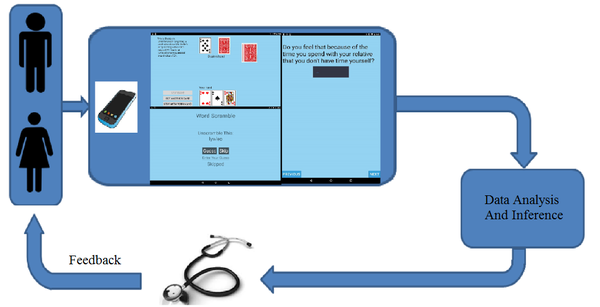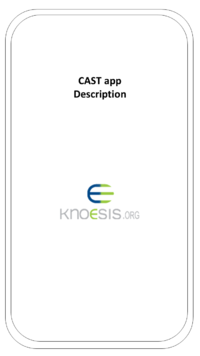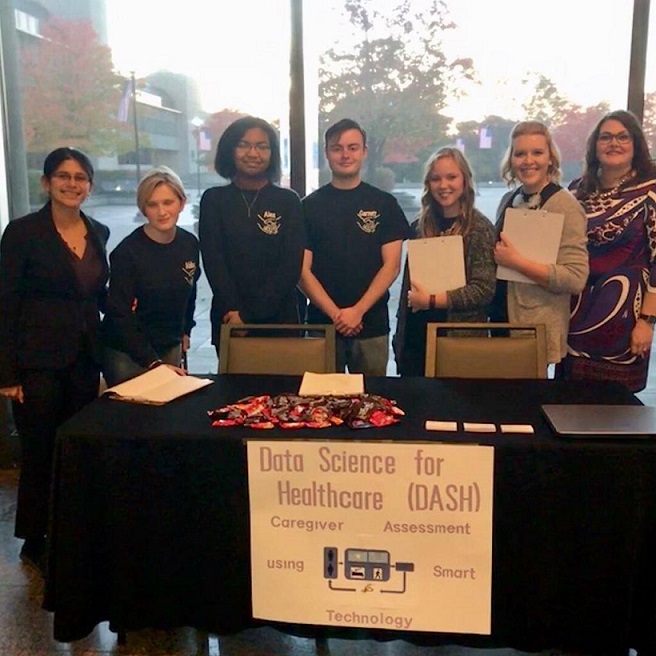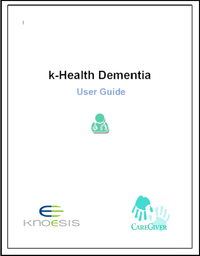Difference between revisions of "Dementia"
(Created page with "==Motivation and Background== More than 25 million people in the U.S. are diagnosed with asthma, out of which 7 million are children [1]. Asthma related healthcare costs alone ar...") |
m (→Project's papers) |
||
| (122 intermediate revisions by 4 users not shown) | |||
| Line 1: | Line 1: | ||
| + | ==In the Media== | ||
| + | Dr. Banerjee and team received recognition for their work in dementia at the Women in Science special issue from UK based magazine Research Features: https://researchfeatures.com/2018/03/07/managing-dementia-through-a-multisensory-smart-phone-application-to-support-ageing-in-place/ | ||
| + | |||
| + | Date: 12/13/18 in Wright State news: http://webapp2.wright.edu/web1/newsroom/2017/12/13/special-care/ | ||
| + | |||
| + | On November 8th, 2017, Miami Valley's Chapter of Alzheimer's Association hosted a Science Night called "Assessing Caregiver Stress and Burnout." For more details: https://alzdayton.wordpress.com/2017/09/25/science-night-assessing-caregiver-stress-and-burnout/ | ||
| + | |||
==Motivation and Background== | ==Motivation and Background== | ||
| − | + | Alzheimer’s disease affects more than 5 million people claiming over 500,000 Americans annually [1]. As the sixth leading cause of death in Americans [1], its management is challenging. Current reactive healthcare costs more than 17% of GDP in the US [3, 4]. Alzheimer’s related healthcare costs alone are around $150 billion a year to Medicare and Medicaid [1]. To add to the challenge, dementia is an umbrella term that encompasses various forms of the disease such as Alzheimer’s disease, vascular dementia, and Huntington’s disease, to name a few [2]. Not only are the healthcare costs associated with dementia staggering, but the impact on the caregivers is also a critical challenge; in 2013, 15.5 million family and friends provided 17.7 billion hours of unpaid care to those with Alzheimer's and other forms of dementia – care valued at $220.2 billion [1]. With the exponential rise of the older population due to the baby boomers, the number of people with Alzheimer’s disease (the most prevalent form of dementia) is estimated to reach around 13.8 million [1,6]. This creates the strong need for unobtrusive sensing modalities that can help monitor people with dementia and support caregivers. | |
| − | == | + | ==Dementia: Challenges and Opportunities== |
| − | + | With increasing adoption of mobile devices and low-cost sensors, an unprecedented amount of data is being collected [5]. However, in the context of dementia, it is challenging to convert this huge amount of data into actionable information that can: a) help detect behavioral changes in an individual with dementia and b) provide relevant information to the clinician supporting them in treating chronic illness. In our previous work, we derived actionable information from physical and physiological data collected from children diagnosed with asthma. We have developed kHealth kit [9, 28] a semantics-enabled smart mobile application with sensors, to capture observations from machine sensors (quantitative) and people (qualitative) in the domain of asthma [30]. We also have active clinical collaborations to investigate and evaluate the use of kHealth technology for reducing readmission of GI (gastrointestinal) and ADHF (acute decompensated heart failure) patients after their discharge from the hospital. | |
| + | <!-- [[File:asthma-health-signals.png | Asthma health signals spanning personal, public, and population level observations |600px]] --> | ||
| − | + | ==CAST ( Caregiver Assessment Using Smart Gaming Technology)== | |
| + | The aim of this study is to detect changes in behavior (agitation, depression, and apathy, see here) and activity patterns of patients with dementia by using a combination of wearable and environmental sensors using a mobile platform. Detecting these behavior changes will result in a deeper understanding of the causes of mood and behavioral changes. This will involve detecting fluctuations in sleep patterns and evaluating the effects on stress using standard clinical methods. This can help predict mood events, which in turn can help alert clinicians for early intervention. | ||
| + | The study will revolve around 10-20 dyads, each comprising a person with dementia (PwD) and his or her main caregiver (Cg). The person with dementia and caregiver must live in the same house or apartment. Sensors will be monitoring the sleep patterns of the patient as well as activity patterns using wearable sensors like the Jawbone UP24 to track parameters like number of steps, location, gait speed as well as wearable garments such as the Sensoria socks for an additional modality to measure gait parameters including speed, cadence, step count, etc. Environmental sensors like the Sense can be used to detect the activity trends. The data can be collected via Bluetooth and processed using an Android-based smartphone. Any abnormal changes in these patterns can then be validated using physical tests like TUG (obtained from the clinician), as well as cognitive tests like the Zarit Burden Interview (obtained from the caregiver). In addition, the effects of psychoactive medications for behavioral disturbances in patients will be associated with changes in their sleep and daily movements. This can provide long-term benefit to patients with dementia to monitor cognitive behavior as well as enable early intervention using ubiquitous sensors in an affordable and non-invasive manner. | ||
| − | + | [[File:Dementia Current 5-9-2017.png | kHealth kit for Asthma |600px]] | |
| − | + | <br/>Figure 1. The kHealth Dementia application will measure physiological signals from the person with dementia as well as the caregiver to provide a deeper understanding of the behavior changes contributing to dementia. | |
| − | + | ==Current Team Members== | |
| − | + | <!-- | |
| − | == | + | |
Asthma is a multi-faceted problem and we propose a holistic solution for <br/> | Asthma is a multi-faceted problem and we propose a holistic solution for <br/> | ||
<b>Personal</b><br/> | <b>Personal</b><br/> | ||
| − | Physiological: Wheezometer [6], Nitric Oxide [7], Accelerometer, Microphone, Contextual Questions <br/> | + | //Physiological: Wheezometer [6], Nitric Oxide [7], Accelerometer, Microphone, Contextual Questions <br/> |
Environmental: Sensordrone [8], Dust Sensor [9], Location<br/> | Environmental: Sensordrone [8], Dust Sensor [9], Location<br/> | ||
<b>Public Health</b><br/> | <b>Public Health</b><br/> | ||
| Line 21: | Line 30: | ||
<b>Population Level</b><br/> | <b>Population Level</b><br/> | ||
Everyaware [11], AirQuality Egg [12], Allergy Alerts [13,14], Social Observations (e.g., tweets), Air Quality Index[15]<br/> | Everyaware [11], AirQuality Egg [12], Allergy Alerts [13,14], Social Observations (e.g., tweets), Air Quality Index[15]<br/> | ||
| + | --> | ||
| + | |||
| − | + | <b>Faculty:</b> Dr. Tanvi Banerjee (CECS, Kno.e.sis, Wright State University), Dr. Jennifer Hughes (Social Work, Wright State University)<br/> | |
| − | + | <b>Mentors:</b> Dr. Larry Lawhorne (Geriatrics, Boonshoft School of Medicine, Wright State University), Dr. Amit Sheth (CECS, Kno.e.sis, Wright State University), Dr. Matthew Peterson (Geriatrics, Boonshoft School of Medicine, Wright State University, Dr. T. K. Prasad (CECS, Kno.e.sis, Wright State University)<br/> | |
| − | + | <b>PhD Students:</b> Reza Sadeghi (Computer Science)<br/> | |
| − | + | <b>Graduate Students:</b> Garrett Goodman (Computer Science), Morgan Freeman (Social Work), Joanna Meyer (Social Work), Brad Schneider (Computer Science)<br/> | |
| − | + | <b>Undergraduate Students:</b> Abby Edwards (Psychology), Alexandrea Oliver (Computer Science) | |
| − | + | ||
| − | + | ||
| − | + | ||
| − | + | ||
| − | + | ||
| − | <br/> | + | |
| − | + | ||
| − | + | [[File:DaSH_Group_Picture2.jpg]] | |
| − | + | ||
| − | == | + | ==Funding== |
| − | + | This project is sponsored by the [https://www.nih.gov/ National National Institutes of Health (NIH)] Grant No. 1K01LM012439 to the [http://knoesis.org/ Ohio Center of Excellence in Knowledge-enabled Computing (Kno.e.sis)] titled: '''Managing Dementia through a Multisensory Smart Phone Application to Support Aging in Place.''' Any opinions, findings, conclusions or recommendations expressed in this material are those of the investigator(s) and do not necessarily reflect the views of the National Institutes of Health. <br /> | |
| + | |||
| + | ==CAST app Description== | ||
| + | Presented at NASA Ohio Space Grant Consortium, 2018 - Alexandrea Oliver.<br/> | ||
| + | [[File:CAST_app_Description.png| CAST app description |200px | link=https://drive.google.com/open?id=1HaPRBJVV6vfUTjCBAGYbSxcSByamPq9w]] | ||
==kHealth User Manual== | ==kHealth User Manual== | ||
| − | |||
| − | |||
| − | |||
| + | [[File:khealthdementiaman.png| kHealth dementia user guide |200px | link=https://drive.google.com/open?id=0B-2OiKiC7xkLVEpfbWs4QVFOZlk]] | ||
| + | <!-- ==kHealth Video Introduction== --> | ||
| + | <!-- {{#ev:youtube|PuQ5F2uVYjM|400|left|kHealth Asthma Application Overview}} --> | ||
| − | |||
| − | |||
| − | |||
| − | |||
| − | |||
| − | |||
| − | |||
| − | |||
| − | |||
| − | |||
| − | |||
| − | |||
| − | |||
| − | |||
| − | |||
| − | |||
| − | |||
| − | |||
| − | |||
| − | |||
| − | |||
| − | |||
| − | |||
| − | |||
| − | |||
| − | |||
| − | |||
| − | |||
| − | |||
| − | |||
| − | |||
| − | |||
| − | |||
| − | |||
| − | |||
| − | |||
| − | |||
| − | |||
| − | |||
| − | |||
| − | |||
==Related Talks and Presentations== | ==Related Talks and Presentations== | ||
| − | {{#ev:youtube | + | <!-- {{#ev:youtube |
|pqcbwGYHPuc | |pqcbwGYHPuc | ||
|400 | |400 | ||
| Line 100: | Line 66: | ||
|padding=20px}} | |padding=20px}} | ||
| − | |||
| − | |||
| − | |||
| − | |||
| − | |||
| − | |||
| − | |||
| − | |||
| − | |||
| − | |||
| − | |||
| − | |||
| − | |||
| − | |||
| − | |||
| − | |||
| − | |||
| − | |||
| − | |||
| − | |||
| − | |||
| − | |||
{{#widget:SlideShare | {{#widget:SlideShare | ||
| − | |doc=khealth- | + | |id=51233935 |
| + | |doc=khealth-hims2015-150803201337-lva1-app6891 | ||
|width=425 | |width=425 | ||
|height=348 | |height=348 | ||
|padding=20px | |padding=20px | ||
}} | }} | ||
| + | --> | ||
| − | |||
| − | |||
| − | + | [[File:Title.png| kHealth dementia paper |400px|433px | link=https://drive.google.com/open?id=0By39GGXx-P9NR29MeUx3b19abDQ]] | |
| + | <br> | ||
| + | <br> | ||
| + | <br> | ||
| + | <html> | ||
| − | |||
| − | |||
| − | |||
| − | + | <iframe src="//www.slideshare.net/slideshow/embed_code/key/4gZ63PC10GwH9V" width="425" height="355" frameborder="0" marginwidth="0" marginheight="0" scrolling="no" style="border:1px solid #CCC; border-width:1px; margin-bottom:5px; max-width: 100%;" allowfullscreen> </iframe> <div style="margin-bottom:5px"> <strong> <a href="//www.slideshare.net/knoesis/2015-presentation-hims" title="Evaluating a Potential Commercial Tool for Healthcare Application for People with Dementia " target="_blank">Evaluating a Potential Commercial Tool for Healthcare Application for People with Dementia </a> </strong> from <strong><a href="//www.slideshare.net/knoesis" target="_blank">Kno.e.sis Center, Wright State University</a></strong> </div></html> | |
| − | |||
| − | |||
| − | + | ==Project's Papers== | |
| − | [ | + | [1] T. Banerjee, P. Anantharam, W. L. Romine, and L. W. Lawhorne, "Evaluating a Potential Commercial Tool for Healthcare Application for People with Dementia," <i>Wright State University CORE Scholar Kno.e.sis Publications</i>, 2015. |
| − | [ | + | [2] J. C. Hughes, T. Banerjee, G. Goodman, and L. W. Lawhorne, “A Preliminary Qualitative Analysis on the Feasibility of Using Gaming Technology in Caregiver Assessment," <i>Journal of Technology in Human Services</i>, vol. 35, no. 3, pp. 183-198, Mar. 2017. |
| − | [ | + | [3] T. Banerjee, M. Peterson, Q. Oliver, A. Froehle, and L. W. Lawhorne, "Validating a Commercial Device for Continuous Activity Measurement in the Older Adult Population for Dementia Management," <i>Smart Health</i>, 2017. |
| − | + | ||
| − | [ | + | [4] R. Sadeghi, T. Banerjee, J. C. Hughes, G. Goodman, and L. W. Lawhorne, “Predicting sleep quality of |
| + | dementia caregivers using physiological signals”, Submitted to <i>Computers in Biology and Medicine</i>, 2019. | ||
| − | [ | + | ==References== |
| + | [1] Alzheimer’s Association description of Alzheimer’s statistics, Available online at: http://www.alz.org/alzheimers_disease_facts_and_figures.asp #quickFacts | ||
| − | [ | + | [2] Dementia related facts, Available online at: http://www.cdc.gov/mentalhealth/basics/mental-illness/dementia.htm |
| − | [ | + | [3] D. A. Squires, “The U.S. Health System in Perspective: A Comparison of Twelve Industrialized Nations,” June 2011, Available online at: http://bit.ly/oZwhFZ |
| − | [ | + | [4] Health Costs: How the U.S. Compares With Other Countries, Available online at: http://www.pbs.org/newshour/rundown/2012/10/health-costs-how-the-us-compares-with-other-countries.html |
| − | [ | + | [5] Quantified Self http://quantifiedself.com/ |
| − | [ | + | [6] G. K. Vincent, V. A. Velkof, “The next four decades: The older population in the United States: 2010 to 2050.” Washington, D.C.: U.S. Census Bureau; 2010. |
| − | + | ||
| − | + | ||
| − | + | ||
| − | + | ||
| − | + | ||
| − | + | ||
| − | + | ||
| − | + | ||
| − | + | ||
| − | + | ||
| − | + | ||
| − | + | ||
| − | + | ||
| − | + | ||
| − | + | ||
| − | + | ||
| − | + | ||
| − | + | ||
| − | + | ||
| − | + | ||
| − | + | ||
| − | + | ||
| − | [ | + | [7] kHealth: A knowledge-enabled semantic platform to enhance decision making and improve health, fitness, and well-being, Available online at: http://knoesis.org/projects/khealth (Accessed May 27, 2013). |
| − | [ | + | [8] A. Sheth, P. Anantharam, K. Thirunarayan, “kHealth: Proactive Personalized Actionable Information for Better Healthcare,” Workshop on Personal Data Analytics in the Internet of Things (PDA@IOT 2014), collocated at VLDB 2014, Hangzhou, China, September 5th 2014. |
| − | [ | + | [9] P. Anantharam, T. Banerjee, A. Sheth, K. Thirunarayan, S. Marupudi, V. Sridharan, S. G. Forbis, "Knowledge-driven Personalized Contextual mHealth Service for Asthma Management in Children", IEEE 4th International Conference on Mobile Services, June 27 - July 2, 2015, New York, USA |
| − | [ | + | ==Related kHealth Projects== |
| + | *[http://knoesis.org/projects/khealth kHealth overview with example of ADHF] | ||
| + | *[http://wiki.knoesis.org/index.php/Asthma Asthma] | ||
| + | *kHealth for reducing liver cirrhosis readmission (to come) | ||
Latest revision as of 21:07, 28 February 2019
Contents
- 1 In the Media
- 2 Motivation and Background
- 3 Dementia: Challenges and Opportunities
- 4 CAST ( Caregiver Assessment Using Smart Gaming Technology)
- 5 Current Team Members
- 6 Funding
- 7 CAST app Description
- 8 kHealth User Manual
- 9 Related Talks and Presentations
- 10 Project's Papers
- 11 References
- 12 Related kHealth Projects
In the Media
Dr. Banerjee and team received recognition for their work in dementia at the Women in Science special issue from UK based magazine Research Features: https://researchfeatures.com/2018/03/07/managing-dementia-through-a-multisensory-smart-phone-application-to-support-ageing-in-place/
Date: 12/13/18 in Wright State news: http://webapp2.wright.edu/web1/newsroom/2017/12/13/special-care/
On November 8th, 2017, Miami Valley's Chapter of Alzheimer's Association hosted a Science Night called "Assessing Caregiver Stress and Burnout." For more details: https://alzdayton.wordpress.com/2017/09/25/science-night-assessing-caregiver-stress-and-burnout/
Motivation and Background
Alzheimer’s disease affects more than 5 million people claiming over 500,000 Americans annually [1]. As the sixth leading cause of death in Americans [1], its management is challenging. Current reactive healthcare costs more than 17% of GDP in the US [3, 4]. Alzheimer’s related healthcare costs alone are around $150 billion a year to Medicare and Medicaid [1]. To add to the challenge, dementia is an umbrella term that encompasses various forms of the disease such as Alzheimer’s disease, vascular dementia, and Huntington’s disease, to name a few [2]. Not only are the healthcare costs associated with dementia staggering, but the impact on the caregivers is also a critical challenge; in 2013, 15.5 million family and friends provided 17.7 billion hours of unpaid care to those with Alzheimer's and other forms of dementia – care valued at $220.2 billion [1]. With the exponential rise of the older population due to the baby boomers, the number of people with Alzheimer’s disease (the most prevalent form of dementia) is estimated to reach around 13.8 million [1,6]. This creates the strong need for unobtrusive sensing modalities that can help monitor people with dementia and support caregivers.
Dementia: Challenges and Opportunities
With increasing adoption of mobile devices and low-cost sensors, an unprecedented amount of data is being collected [5]. However, in the context of dementia, it is challenging to convert this huge amount of data into actionable information that can: a) help detect behavioral changes in an individual with dementia and b) provide relevant information to the clinician supporting them in treating chronic illness. In our previous work, we derived actionable information from physical and physiological data collected from children diagnosed with asthma. We have developed kHealth kit [9, 28] a semantics-enabled smart mobile application with sensors, to capture observations from machine sensors (quantitative) and people (qualitative) in the domain of asthma [30]. We also have active clinical collaborations to investigate and evaluate the use of kHealth technology for reducing readmission of GI (gastrointestinal) and ADHF (acute decompensated heart failure) patients after their discharge from the hospital.
CAST ( Caregiver Assessment Using Smart Gaming Technology)
The aim of this study is to detect changes in behavior (agitation, depression, and apathy, see here) and activity patterns of patients with dementia by using a combination of wearable and environmental sensors using a mobile platform. Detecting these behavior changes will result in a deeper understanding of the causes of mood and behavioral changes. This will involve detecting fluctuations in sleep patterns and evaluating the effects on stress using standard clinical methods. This can help predict mood events, which in turn can help alert clinicians for early intervention. The study will revolve around 10-20 dyads, each comprising a person with dementia (PwD) and his or her main caregiver (Cg). The person with dementia and caregiver must live in the same house or apartment. Sensors will be monitoring the sleep patterns of the patient as well as activity patterns using wearable sensors like the Jawbone UP24 to track parameters like number of steps, location, gait speed as well as wearable garments such as the Sensoria socks for an additional modality to measure gait parameters including speed, cadence, step count, etc. Environmental sensors like the Sense can be used to detect the activity trends. The data can be collected via Bluetooth and processed using an Android-based smartphone. Any abnormal changes in these patterns can then be validated using physical tests like TUG (obtained from the clinician), as well as cognitive tests like the Zarit Burden Interview (obtained from the caregiver). In addition, the effects of psychoactive medications for behavioral disturbances in patients will be associated with changes in their sleep and daily movements. This can provide long-term benefit to patients with dementia to monitor cognitive behavior as well as enable early intervention using ubiquitous sensors in an affordable and non-invasive manner.

Figure 1. The kHealth Dementia application will measure physiological signals from the person with dementia as well as the caregiver to provide a deeper understanding of the behavior changes contributing to dementia.
Current Team Members
Faculty: Dr. Tanvi Banerjee (CECS, Kno.e.sis, Wright State University), Dr. Jennifer Hughes (Social Work, Wright State University)
Mentors: Dr. Larry Lawhorne (Geriatrics, Boonshoft School of Medicine, Wright State University), Dr. Amit Sheth (CECS, Kno.e.sis, Wright State University), Dr. Matthew Peterson (Geriatrics, Boonshoft School of Medicine, Wright State University, Dr. T. K. Prasad (CECS, Kno.e.sis, Wright State University)
PhD Students: Reza Sadeghi (Computer Science)
Graduate Students: Garrett Goodman (Computer Science), Morgan Freeman (Social Work), Joanna Meyer (Social Work), Brad Schneider (Computer Science)
Undergraduate Students: Abby Edwards (Psychology), Alexandrea Oliver (Computer Science)
Funding
This project is sponsored by the National National Institutes of Health (NIH) Grant No. 1K01LM012439 to the Ohio Center of Excellence in Knowledge-enabled Computing (Kno.e.sis) titled: Managing Dementia through a Multisensory Smart Phone Application to Support Aging in Place. Any opinions, findings, conclusions or recommendations expressed in this material are those of the investigator(s) and do not necessarily reflect the views of the National Institutes of Health.
CAST app Description
Presented at NASA Ohio Space Grant Consortium, 2018 - Alexandrea Oliver.

kHealth User Manual
Related Talks and Presentations
Project's Papers
[1] T. Banerjee, P. Anantharam, W. L. Romine, and L. W. Lawhorne, "Evaluating a Potential Commercial Tool for Healthcare Application for People with Dementia," Wright State University CORE Scholar Kno.e.sis Publications, 2015.
[2] J. C. Hughes, T. Banerjee, G. Goodman, and L. W. Lawhorne, “A Preliminary Qualitative Analysis on the Feasibility of Using Gaming Technology in Caregiver Assessment," Journal of Technology in Human Services, vol. 35, no. 3, pp. 183-198, Mar. 2017.
[3] T. Banerjee, M. Peterson, Q. Oliver, A. Froehle, and L. W. Lawhorne, "Validating a Commercial Device for Continuous Activity Measurement in the Older Adult Population for Dementia Management," Smart Health, 2017.
[4] R. Sadeghi, T. Banerjee, J. C. Hughes, G. Goodman, and L. W. Lawhorne, “Predicting sleep quality of dementia caregivers using physiological signals”, Submitted to Computers in Biology and Medicine, 2019.
References
[1] Alzheimer’s Association description of Alzheimer’s statistics, Available online at: http://www.alz.org/alzheimers_disease_facts_and_figures.asp #quickFacts
[2] Dementia related facts, Available online at: http://www.cdc.gov/mentalhealth/basics/mental-illness/dementia.htm
[3] D. A. Squires, “The U.S. Health System in Perspective: A Comparison of Twelve Industrialized Nations,” June 2011, Available online at: http://bit.ly/oZwhFZ
[4] Health Costs: How the U.S. Compares With Other Countries, Available online at: http://www.pbs.org/newshour/rundown/2012/10/health-costs-how-the-us-compares-with-other-countries.html
[5] Quantified Self http://quantifiedself.com/
[6] G. K. Vincent, V. A. Velkof, “The next four decades: The older population in the United States: 2010 to 2050.” Washington, D.C.: U.S. Census Bureau; 2010.
[7] kHealth: A knowledge-enabled semantic platform to enhance decision making and improve health, fitness, and well-being, Available online at: http://knoesis.org/projects/khealth (Accessed May 27, 2013).
[8] A. Sheth, P. Anantharam, K. Thirunarayan, “kHealth: Proactive Personalized Actionable Information for Better Healthcare,” Workshop on Personal Data Analytics in the Internet of Things (PDA@IOT 2014), collocated at VLDB 2014, Hangzhou, China, September 5th 2014.
[9] P. Anantharam, T. Banerjee, A. Sheth, K. Thirunarayan, S. Marupudi, V. Sridharan, S. G. Forbis, "Knowledge-driven Personalized Contextual mHealth Service for Asthma Management in Children", IEEE 4th International Conference on Mobile Services, June 27 - July 2, 2015, New York, USA
Related kHealth Projects
- kHealth overview with example of ADHF
- Asthma
- kHealth for reducing liver cirrhosis readmission (to come)


